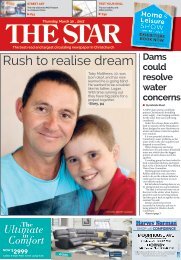Review of the Tsunami Evacuation 2017
Create successful ePaper yourself
Turn your PDF publications into a flip-book with our unique Google optimized e-Paper software.
Figure 2 The necessary components for effective end-to-end (detection to public action) early warning<br />
systems. Source Leonard et al 2008. Available here: http://www.civildefence.govt.nz/cdem-sector/cdemframework/guidelines/public-alerting-options-assessment/<br />
5 Background “caused confusion right across<br />
New Zealand”<br />
This is an opinion statement and not fact. The event was highly complex and during <strong>the</strong> first hour<br />
in particular <strong>the</strong> assessment <strong>of</strong> <strong>the</strong> hazard was very difficult for scientists. It was unclear until<br />
wave action was detected that <strong>the</strong>re was a tsunami threat. This made <strong>the</strong> provision <strong>of</strong> clear<br />
messaging more challenging. It is acknowledged that <strong>the</strong> first two National Warning System<br />
messages in particular required more detail but stating <strong>the</strong>re was “confusion right across New<br />
Zealand” is subjective and arguably inaccurate. Despite <strong>the</strong> uncertainty (which is to be expected in<br />
such complex geological events), many communities around New Zealand (including in<br />
Canterbury) self-evacuated following <strong>the</strong> natural warning <strong>of</strong> <strong>the</strong> earthquake. These people took<br />
<strong>the</strong> correct action under <strong>the</strong> circumstances and MCDEM applauds <strong>the</strong>ir actions. For any large<br />
earthquake (>M7) in New Zealand , getting clear information will always be both a challenge and a<br />
64















